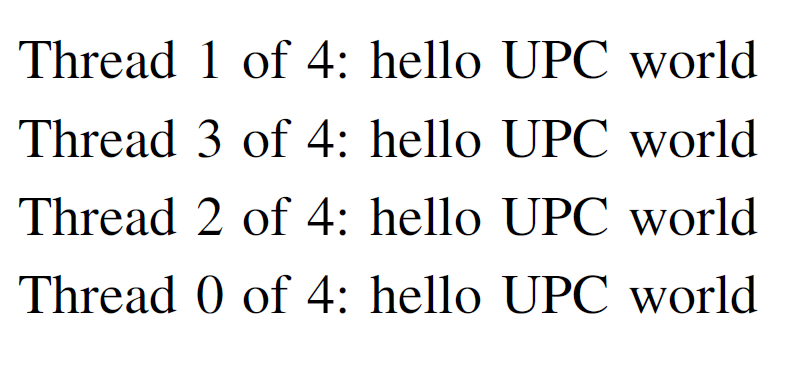1.1 - HelloWorld程序入门
THREADS - 运行时的线程总数量
MYTHREAD - 每个线程自身的ID
#include <upc.h> #include <stdio.h> main() { printf("Thread %d of %d: hello UPC world\n",MYTHREAD, THREADS); }
以上hello world程序的一种可能结果为:

1.2 - private and shared data
公有变量(shared variables):可用于线程间通信
私有变量(private variables):有性能优势(UPC中变量默认是私有的)
1 #include <stdio.h> 2 #include <upc.h> 3 main () 4 { 5 static shared int step=10; 6 int fahrenheit, celsius; 7 celsius= step*MYTHREAD; 8 fahrenheit= celsius*(9.0/5.0) + 32; 9 printf ("%d \t %d \n", fahrenheit, celsius); 10 }
以上是一个华氏度-摄氏度转换程序,第6行为每个线程实例化了两个变量fahrenheit, celsuis。第5行,用shared关键字声明了一个公有变量step,即只有一个step的实例(instance),且其对所有线程都是可见并可访问的。static关键字保证了全局可用(动态变量可能在某一个线程退出其声明域
后被销毁)
改进:
1 #include <stdio.h> 2 #include <upc.h> 3 #define TBL_SZ 12 4 main () 5 { 6 static shared int step=10; 7 int fahrenheit, celsius, i; 8 for (i=0; i< TBL_SZ; i++) 9 if (MYTHREAD == i%THREADS) 10 { 11 celsius = step*i; 12 fahrenheit = celsius*(9.0/5.0) + 32; 13 printf ("%d \t %d \n", fahrenheit, celsius); 14 } 15 }
第8、9行,循环地为每个线程分配一次迭代。如,线程0执行第0次、THREADS次、2*THREADS次·····迭代;线程1执行第1次、THREADS+1次、2*THREADS+1次·····迭代,以此类推。即每个线程都执行所有与其关于THREADS同余次的迭代。以上程序是低效的,因为每个线程都要判断13次for循环。更聪明的改进是,将for循环改成:for(i=MYTHREAD; i < TBL_SZ; i+=THREADS),每个线程最多判断TBL_SZ/THREADS+1次for。
1.3 SHARED ARRAYS AND AFFINITY OF SHARED DATA
1 #include <stdio.h> 2 #include <upc.h> 3 #define TBL_SZ 12 4 main () 5 { 6 static shared int fahrenheit[TBL_SZ]; 7 static shared int step=10; 8 int celsius, i; 9 for(i=MYTHREAD; i < TBL_SZ; i+=THREADS) 10 { 11 celsius= step*i; 12 fahrenheit[i]= celsius*(9.0/5.0) + 32; 13 } 14 if(MYTHREAD==0) 15 for (i=0 ; i < TBL_SZ; i++) 16 { 17 celsius= step*i; 18 printf ("%d \t %d \n", fahrenheit[i], celsius); 19 } 20 }
第6行定义的数组是公有的。在UPC中,对公有空间(shared space)会执行逻辑划分(logical partitioning),使得公有空间中的每个变量都恰好与一个线程相关联(affinity to exactly one thread)。这里的这个数组的每个元素会被以轮转法(round robin fashion)分配给每个线程:fahrenheit[0]与thread0,fahrenheit[1]与thread1····每个线程都有了一个元素后再从头循环。这是UPC中的默认分配模式。但也可以按块分配(blocked distributions),见后文。
UPC有两个重要的特性:对数据布局data layout的控制,以及,对工作分配work distribution 的控制。
每个线程的首要任务是处理与其关联的数据,UPC会将他们映射到同一个处理结点processing node上。
公有的非数组类型变量(shared scalar variables)永远与线程0相关联。
以上程序的结果会出错,因为thread0可能在计算还没完成前就执行打印。
1.4同步与内存一致性
我们在13与14行之间添加“upc_barrier;”
这可以保证任何线程想要继续往下执行,必须等待其他所有线程也到达这个点。他也可以用于线程对临界区数据的读取,以保证线程互斥。
1.5 Work sharing
1 #include <upc.h> 2 #define TBL_SZ 12 3 main () 4 { 5 static shared int fahrenheit [TBL_SZ]; 6 static shared int step=10; 7 int celsius, i; 8 upc_forall(i=0; i <TBL_SZ; i++; i) 9 { 10 celsius= step*i; 11 fahrenheit[i]= celsius*(9.0/5.0) + 32; 12 } 13 upc_barrier; 14 if(MYTHREAD==0) 15 for (i=0; i < TBL_SZ; i++) 16 { 17 celsius= step*i; 18 printf ("%d \t %d \n", fahrenheit [i], celsius); 19 } 20 }
关键语句:upc_forall(i=0; i <TBL_SZ; i++; i)
与C语言的差别关键看最后一个分号,这个i表示,第i次迭代,由i除以总线程数的余数的那个线程来执行(i modulo THREADS)。
由于迭代序数和数组编号一样,每个线程只会处理关联的数组元素,提高了性能。
1.6 UPC 指针
没差多少的程序·····
1 main () 2 { 3 static shared int fahrenheit [TBL_SZ]; 4 shared int *fahrenheit_ptr=fahrenheit; 5 static shared int step=10; 6 int celsius, i; 7 upc_forall(i=0; i <TBL_SZ; i++; i) 8 { 9 celsius= step*i; 10 fahrenheit [i]= celsius*(9.0/5.0) + 32; 11 } 12 upc_barrier; 13 if(MYTHREAD==0) 14 for (i=0 ; i < TBL_SZ ; i++) 15 { 16 celsius= step*i; 17 printf ("%d \t %d \n", *fahrenheit_ptr++, celsius); 18 }
第4行,这是一个指向共享类型的私有指针,每个线程都有一个它的拷贝,可以独立地访问数组,初始化时全都指向首元素。虽然指针指向共享变量,但其本身是私有的,每个线程都有它的一个独立实例
1 static shared int fahrenheit [TBL_SZ]; 2 shared int *fahrenheit_ ptr; 3 static shared int step=10; 4 int celsius, i; 5 fahrenheit_ptr = fahrenheit + MYTHREAD; 6 upc_forall(i=0; i <TBL_SZ; i++; i) 7 { 8 celsius = step*i; 9 *fahrenheit_ptr = celsius*(9.0/5.0) + 32; 10 fahrenheit_ptr += THREADS; 11 } 12 upc_barrier;
第5行,初始化每一个指针,将其指向数组中第一个与每个指针相关联的元素
1.7总结
SPMD模型
公有标量与thread 0关联
C语言的指针声明,结果是私有指针指向私有数据
UPC允许把一个类型的指针指向另一种类型